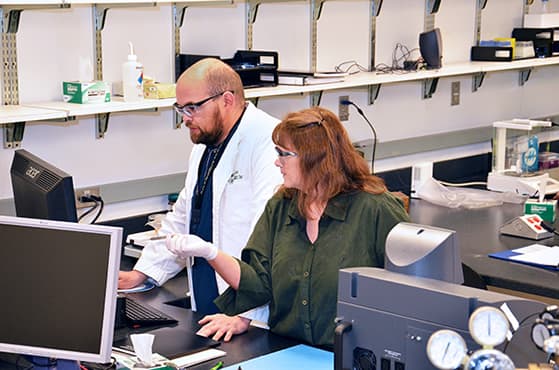Materials Characterization Lab moves to new home

The Lee College of Engineering’s Materials Characterization Lab is now in the Cameron Applied Research Center. The facility provides faculty and student researchers with analysis of advanced materials, as well as sampling services, training, shared instrument usage and expertise at an affordable cost.
Katherine Weaver, lab director, said, “The MCL is our way to help grow research on campus. We can run a small sample for an individual project or support a full thesis or dissertation research program. Right now, we work with undergraduate and graduate students and faculty from chemistry, biology, all of the engineering disciplines and architecture.”
The lab has existed for several years; however, funding and support from the Energy Production and Infrastructure Center and the Infrastructure, Design, Environment and Sustainability Center enabled it to move to its current location.
Weaver, who holds a Ph.D. in chemistry from Duke University, is an expert in analytical chemistry and materials science. She said by providing shared resources, the lab gives researchers the option to do advanced analysis without having to purchase and maintain their own expensive equipment. Also, the researchers can get samples processed when their departmental lab equipment is in use for other projects, and they can do proof-of-concept research necessary for grant proposals.
“We now have a growing group of researchers using the lab. They are from our University and other campuses, and we have a number of industrial clients,” stated Weaver.
Gloria Elliott, a faculty member in the Department of Mechanical Engineering and Engineering Science, has used the lab since its inception. She noted, “We currently use the DMA (Dynamic Mechanical Analyzer) to study sugar glasses that we use in our bio-preservation research. The DMA helps us understand how the molecules and parts of molecules move, and how that impacts their ability to function as a storage medium.”
This type of analysis would not be economically feasible without the shared MCL facility, Elliott said. “The MCL is an incredibly valuable resource, especially with the escalating costs of maintaining and repairing analytical equipment. We wouldn’t be able to afford this type of analysis through a single research grant; we just couldn’t keep up with costs. This shared resource is fantastic.”
Clark Snell, a master’s student in architecture, is another researcher who uses the lab.
“I’m working with the geopolymer concrete we used in the Solar Decathlon house,” Snell said. “I’m trying to quantify the thermal properties on a component level, so we can optimize these thermal properties and the thermal conductivity to create an optimum concrete mixture.”
Weaver trained Snell to use a Sensys Evo differential scanning calorimeter for his research. By heating samples and measuring the energy they absorb, the Sensys Evo measures the specific heat of the material.
“For me as an architecture student without an extensive chemistry background,” Snell said, “having Dr. Weaver to teach me how to do this work has been great. There’s really no way I could have done my thesis work on campus without this facility.”
The Materials Characterization Lab is a charge-back unit, with varying rates based on the equipment used. It accepts industry research projects provided there is equipment time available. Officials note there is not an equivalent research service offered by a for-profit company at a lower rate, and the industry users agree to, and sign a services agreement covering confidentiality and intellectual property.
Photo: Lab director Katherine Weaver works with Matt Van Vorst, a technician who performs cryopreservation research with Gloria Elliott, a faculty member in the Department of Mechanical Engineering and Engineering Science.